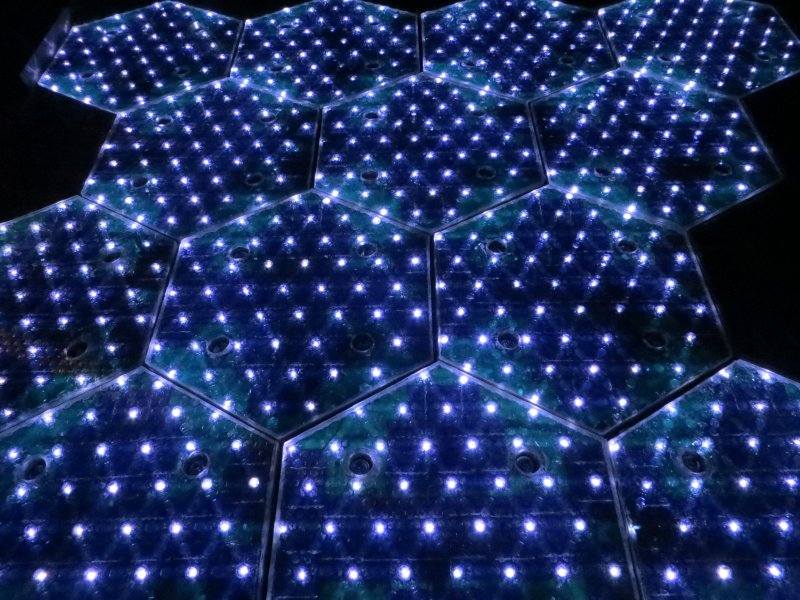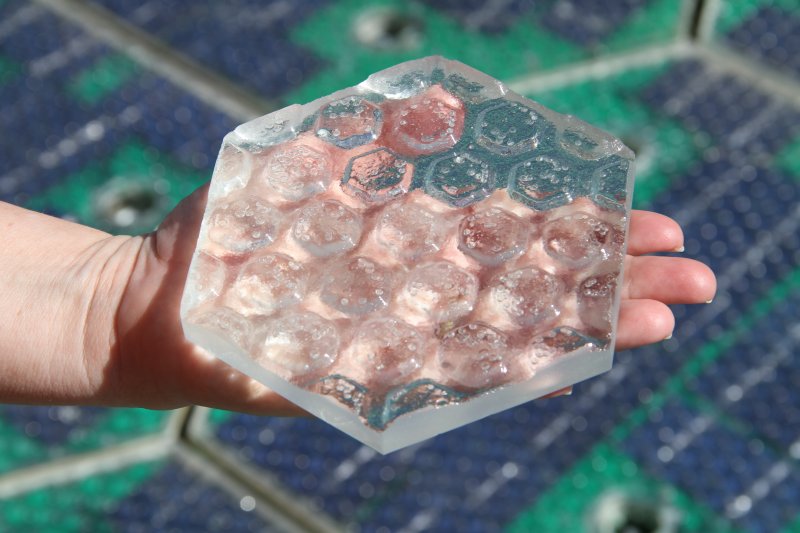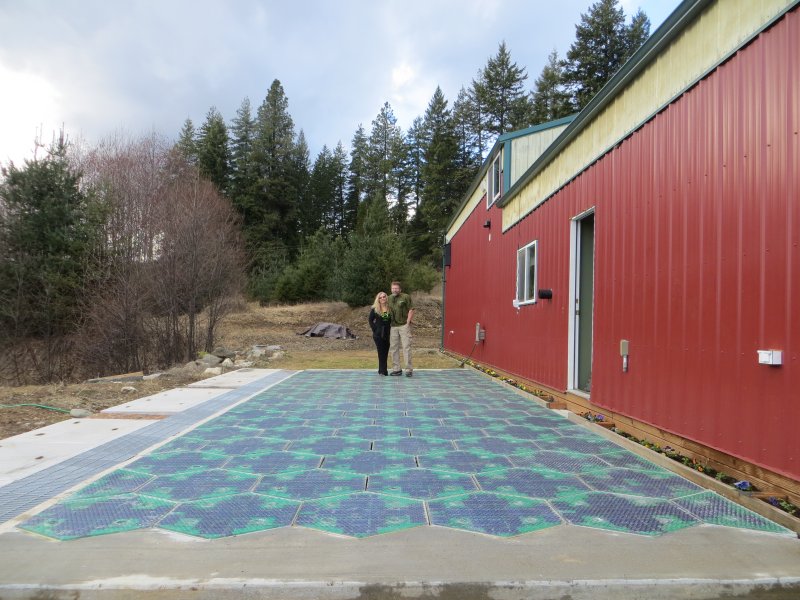May 27, 2014 – What if we could pave parking lots, walkways and roads with solar panels? Solar Roadways, a modular paving system, says we can. It went on Indiegogo to tell its story and raise $1 million. To-date pledges of $1.374 million have come in with five days to go in the campaign. A $1,000 pledge gets you a 10 centimeter (4 inch) glass hexagon, as seen below, containing the same textured surface as one of the modular panels.
Is this for real? On the company’s website they state their vision “to cover all concrete and asphalt surfaces that are exposed to the sun with Solar Road Panels. This will lead to the end of our dependency on fossil fuels of any kind.” Besides the issue of the Sun not coming out at night it would seem to be a more than monumental task to accomplish what Solar Roadways wants to do.
In all fairness to them they intend to start small with sidewalks, parking lots, patios and playgrounds. Each solar road panel, however, will be designed to be far more robust in handling traffic than just these types of venues. The modules are rated to withstand weights of up to 113,000 kilograms (250,000 pounds). That’s more weight than the biggest semi-trailer rig you could imagine and more than double the weight of the latest model of the Abrams tank.
From the FAQs I have gleaned the following about what exists and what is being proposed.
- The panels are being designed to last minimally 20 years with 30 years being the lifespan before replacement. Right now a prototype parking lot is under construction.
- The surfaces are variable from semi-smooth for walkways to slightly raised hexagons with textured surfaces for roads and parking areas to provide traction for walking, automobiles and trucks.
- The surfaces appear to be skid mark resistant with wind and rain able to wash the surfaces clean, and even when dirty the total power loss is less than 9% of the maximum.
- The panels can use any kind of solar cell currently on the market.
- The roadways and parking areas would pay for themselves from the power generated but there are other sources of revenue such as leasing rights of way for utility companies, selling electronic messaging and advertising, and parking recharging stations for EVs.
- The excess energy produced by the panels would be sold to the local utility and power from the utility could be delivered as heat to the panel surfaces in colder climates to ensure they remain snow and ice free through the winter.
- The panels can have storage added to the system in the form of batteries, flywheels and other energy retaining technologies.
- The panels use existing roads, parking lots and sidewalk surfaces as a substrate for installation so that no roads need to be ripped up and repaved.
- Funding for the solar panel roadways could come from existing budgets for road maintenance and construction. There is no need for an extraordinary increase in existing highway budgets.
- The roadways would feature built-in LED lighting and signage to minimize the need for external light sources and distracting overhead displays.
- The panels are suitable for micro-grid and local power generation minimizing security threats and potential power failures.
- The modular design of the panels will make them easy to repair should one be damaged because each features a microprocessor at its core and network communication with neighboring panels making it easy to identify a failure, and make the repair.
- The panels will even produce significant amounts of energy even when a parking lot is full or the highway is jammed with traffic because congestion only impacts a small portion of the total surface exposed to the Sun.
- The panels can be designed with LED messages for drivers to slow down before a crosswalk where a pedestrian is walking, or for known road hazards communicated through the network.
So how much power can a parking lot like the one depicted below generate? In the prototype developed by Solar Roadways a parking lot with 69% coverage generated 3,600 watts. If fully covered the power generation would be 5,200 watts. This would vary depending on the availability of sunlight and the season.
Worst case scenarios such as earthquakes and volcanic eruptions would seriously impact a Solar Roadway just as they would any existing road technology. But for the more common extreme events such as a storm or flood which would deposit debris on the road surface the same cleaning equipment that paved roads used could quickly restore the solar power generating capability of the modules. The same is true for a human-made disaster such as an oil spill.
In the United States the Federal Highway Administration has provided Solar Roadways with two phases of funding which has included testing of the structural integrity, LEDs, wireless connectivity and communication, microprocessors, and photovoltaics of the modules. The company was a 2013 finalist for the World Technology Award for Energy. Google chose it as one of its Moonshots in May of 2013.
Co-inventors are Scott and Julie Brusaw. He is an electrical engineer. She is a psychology counselor. And the two of them have nurtured their innovation from concept back in the 1990s to prototype and caught the attention of the U.S. government and Google. If it works this could be among the most disruptive technologies to enter the energy marketplace altering the way we generate electricity on this planet, and accelerating the timetable to end our fossil-fuel based energy infrastructure.











